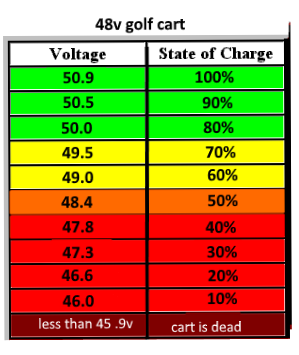ok first make sure batteries are fully charged
here is a good guide
if full power then the you will need tO test the MCOR
if you do not know your way around a muilt - meter then i'd take your cart to a golf cart shop
Procedure to test an MCOR with a Volt Meter
MCOR Voltage Test
1. Place chocks at the front wheels and lift the rear of the vehicle with a chain hoist or floor jack. Position
jack stands under the frame crossmember between the spring mount and side stringer, just forward of
each rear wheel. See WARNING “Lift only one end...” in General Warning, Section 10, Page 10-1.
See following NOTE.
NOTE: The key switch should be placed in the OFF position and left in the OFF position for the duration of
this test.
2. With the batteries connected, place Tow/Run switch in RUN. Using a multimeter set to 200 volts DC,
place red (+) probe on battery no. 1 positive post and place black (–) probe (with insulation-piercing
probe) on the purple/white wire (1) at a point close to the three-pin connector at the MCOR (Figure
11-11). The reading should be approximately 48-50 volts (full battery voltage).
Figure 11-11 Test MCOR: Purple/White Wire (+)
2008 IQ Plus Electric Vehicle Maintenance and Service Supplement Page 11-19
11
3. If reading is zero volts, check the purple/white wire continuity from the three-pin connector at the MCOR
same as Precedent
to the 24-pin connector at the speed controller. Check terminal positions in three-pin connector at the
MCOR and the 24-pin connector. If all of the continuity readings are correct and the connectors are wired
correctly, replace the speed controller.
4. With multimeter set to 20 volts DC, place the black (–) probe on battery no. 8 negative post and the red
(+) probe (with insulation-piercing probe) on the white wire (2) at a point close to the three-pin connector
at the MCOR (Figure 11-12). The reading should be approximately 4.65 volts.
5. If reading is zero volts, check the white wire continuity from the three-pin connector at the MCOR to the
24-pin connector at the speed controller. Check terminal positions in three-pin connector at the MCOR
and the 24-pin connector. If all of the continuity readings are correct and the connectors are wired correctly,
replace the speed controller.
6. With multimeter set to 20 volts DC, place the black (–) probe on battery no. 8 negative post and the red
(+) probe (with insulation-piercing probe) on the yellow wire (3) at a point close to three-pin connector at
the MCOR (Figure 11-13). The reading should be approximately 0.32 volts with the pedal up. Slowly
press the accelerator pedal and note the readings on the multimeter. As the pedal is pressed, the reading
should increase until it reaches 4.65 volts when the pedal is fully pressed.
7. If reading does not increase as the pedal is pressed, replace the MCOR.
8. If the reading is not approximately 4.60 volts with the pedal fully pressed, the vehicle will not operate at
rated top speed. Check the MCOR resistance.
8.1. Disconnect the battery cables as instructed. See WARNING “To avoid unintentionally start-
Figure 11-12 Test MCOR: White Wire (+)
Figure 11-13 Test MCOR: Yellow Wire (+)
Passenger Side Frame Rail
3
ELECTRICAL SYSTEM AND TESTING Troubleshooting
Page 11-20 2008 IQ Plus Electric Vehicle Maintenance and Service Supplement
11
ing...” in General Warning, Section 10, Page 10-1.
8.2. Disconnect the 24-pin connector at the speed controller.
8.3. Set a multimeter to 20k ohms. Connect the red (+) probe of the multimeter to the yellow wire at the
MCOR three-pin connector with an insulation piercing probe. Connect black (–) probe to the purple/
white wire with an insulation-piercing probe.
8.4. With the accelerator pedal fully up (not pressed), the multimeter should read approximately 1k
ohms.
8.5. Slowly press the accelerator pedal while monitoring the multimeter. The resistance should rise as
the pedal is pressed. When the pedal is all the way to the floor, the multimeter should indicate
between 5.67k ohms and 7.43k ohms.
8.6. Using a multimeter set for 20k ohms, connect the red (+) probe of the multimeter to the yellow wire
at the MCOR three-pin connector with an insulation piercing probe. Connect black (–) probe to the
white wire with an insulation-piercing probe.
8.7. With the accelerator pedal fully up (not pressed), the multimeter should indicate between 5.67k
ohms and 7.43k ohms.
8.8. Slowly press the accelerator pedal while monitoring the multimeter. The resistance should drop as
the pedal is pressed. When the pedal is all the way to the floor, the multimeter should indicate
approximately 1k ohms.
8.9. If the MCOR does not operate as described, replace the MCOR.
i needed i can send you the pdf file on trouble shooting






